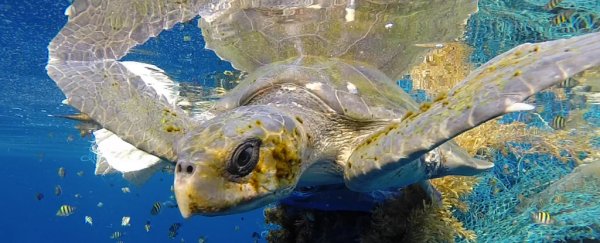Finding safety in numbers is a key survival strategy for many animals. It's deployed in spectacular fashion by turtles when they're at their most vulnerable - as tiny hatchlings on land.
Before this life stage, turtle mothers gather offshore in phenomenal swarms to synchronise their egg laying. Thus, they provide at least some of their fragile babies a chance to make it past eagerly waiting predators.
Marine biologist Vanessa Bézy recently shared remarkable footage of one of the largest known offshore turtle gatherings, at Costa Rica's Ostional National Wildlife Refuge, which she captured using a drone during her research in 2016.
"On this day, there was an equivalent of about 5,000 sea turtles within the area of a football field, covering a total area of more than 1,000 football fields," the video explains.
"And that's not even counting the turtles below the surface."
In 2017, Bézy and colleagues published a paper after conducting a pilot study on using drones as a means to monitor sea turtle population numbers. They estimated a density of as many as 2,086 turtles per square kilometre at peak gatherings near the shore.
These crowded swimmers are mostly olive ridley sea turtles (Lepidochelys olivacea), and while they're the most abundant sea turtle in the world their numbers have been declining and they're listed as vulnerable by the IUCN.
Avoiding predation is one of several possible reasons for the turtles' remarkable synchronised nesting; researchers suspect that a number of factors are involved. Other options to explain this behaviour include timing breeding for the best seasonal conditions, and increasing multiple mating opportunities.
No one knows how the turtles coordinate their intense gatherings.
As their sex is determined by the temperature their eggs incubate at, just like other sea turtles, olive ridleys are highly vulnerable to the effects of climate change. While synchronised nesting likely helped these turtles flourish in the past, human activities may have turned their breeding strategy into a disadvantage.
"In terms of conservation, gathering together at the same time and in the same place to nest makes female olive ridleys vulnerable to human disturbance and could jeopardise their survival," biologist Virginie Plot from National Center for Scientific Research, who studied the same species in French Guiana, explained in 2011.
The turtles in Ostional are facing many of these human disturbances, including tourism, rapid beachfront development, and even egg poaching.
"The Wildlife Conservation Association is developing programs to protect sea turtles and other wildlife at this site and is currently leading a campaign to establish a center that will house all of these activities," Bézy wrote in the video caption.
She is working with citizen scientists and the local community to educate the public about these magnificent reptiles and hopes the video will help to raise awareness.
H/T: National Geographic.
